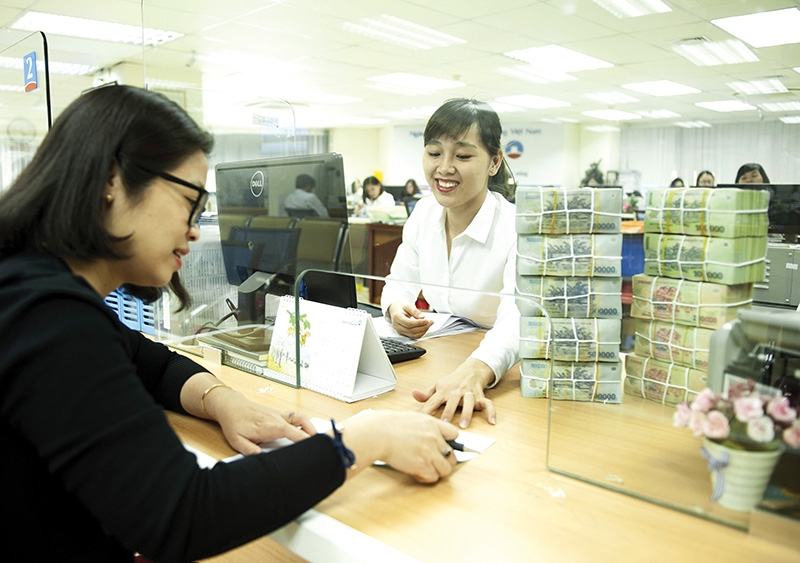Credit institutions commit to doing their bit for the pandemic recovery
 |
| Credit institutions commit to doing their bit for the pandemic recovery. Photo: Le Toan |
The State Bank of Vietnam (SBV) last week released Official Letter No.5901/NHNN asking credit institutions to lower interest rates and provide free banking services to aid customers adversely hit by the pandemic. “The execution of programmes to lower interest rates and reduce service fees has to be substantial, effective, and deliver concrete outcomes,” the SBV stated.
The first report is to be delivered no later than August 31.
“The SBV will strengthen supervision and publicly announce the results of interest rates and fee reduction programmes of each bank on mass media on a monthly basis,” the central bank noted. “Banks failing to fulfil their commitments will bear the risk of stringent credit limit growth.”
Previously, the central bank’s Deputy Governor Dao Minh Tu indicated that 16 credit institutions had decided to commit to solutions to boost the economy until the end of the year with an anticipated value of over $890 million.
Particularly, the four big state-owned commercial banks also committed to lower interest rates for businesses and people in the most difficult localities. They have also eliminated all costs banking services for locations such as Ho Chi Minh City and Binh Duong province.
“In order for the assistance to be substantial, banks must periodically report outcomes of support measures as pledged to comply with the directive on helping the economy,” said Tu.
State-owned lender BIDV claimed to help clients through a variety of relief measures. The bank is planning to continue to help its clients with an overall assistance of up to $156.5 million during the second half of the year.
A representative from southern Viet Capital Bank told VIR that the lender will strictly follow the SBV’s directives and also implement relief measures like reducing rates and debts reschedules to support affected customers, thus contributing to the outstanding Vietnamese economy’s success narrative.
Experts predicted that interest rate reductions were uneven in extent and length, depending on the loan portfolio structure of each bank. These places strain on banks’ net interest margin (NIM) and, in turn, impacts their growth performance.
Particularly, in H2/2021, current rivalries among banks will become more intense in terms of fees and retail penetration, which is driven by cashless payments and the digital transition.
The NIM’s growth tendency, on the other hand, is believed to be curtailed by favourable interest rate packages, according to Viet Dragon Securities Company (VDSC).
Lending yields will continue to shrink in H2, with further assistance packages, with varying effectiveness. In 2022, loan interest rates may rise again if the pandemic is well managed.
“With positive credit growth anticipated NIM is likely to decrease, while net interest income in the second half of 2021 is projected to increase slower than in the first,” the VDSC concluded.
However, with the expectation that the pandemic will be controlled within September thanks to accelerated vaccinations, the banking sector could still enjoy the peak season in Q4 to help total credit growth of the economy reach 9-10 per cent in 2021, according to Tran Thi Hong Nhung, analyst at Guotai Junan Securities Vietnam.
In particular, the listed banking group will get an average credit growth of 15 per cent. In terms of profitability, there will a differentiation among state-owned banks, top commercial bank groups, and small commercial groups.
Nhung said, “Small -scale and focused customer segments make it easy for small commercial banks to expand credit balance and thus achieve impressive growth rates. In contrast, state-owned banks would face challenges for various reasons, such as eroded profits, as promoting customer support and reducing interest rates under the direction of SBV is affected by the pandemic and risks of increasing bad debts.”
State-owned banks, such as Agribank, are often lagging in the digitalisation journey, while their large branch network across the country also bears the risk of high operating cost. The recent changes at the executive levels of Vietcombank and VietinBank might also shift their appetite and strategies.
VDSC predicted that banks’ operating income will continue to soar steadily, although the expansion will be smaller than in H1/2021 when the SBV became more cautious in providing credit lines.
“In the medium and long run, the industry is projected to perform better in 2022, with the expectation that the economy would recover from the pandemic, particularly if the majority of the population is vaccinated,” Nhung said.
What the stars mean:
★ Poor ★ ★ Promising ★★★ Good ★★★★ Very good ★★★★★ Exceptional
 Tag:
Tag:
Related Contents
Latest News
More News
- Vietnam’s green transition demands collective financial action (December 15, 2025 | 12:00)
- VIR workshop highlights capital and policy for sustainable development (December 15, 2025 | 11:00)
- National Assembly approves pilot mechanisms to accelerate major projects in Hanoi (December 12, 2025 | 11:29)
- Vietnam eases policy approval requirements, simplifies foreign and outbound investments (December 11, 2025 | 17:53)
- Unpacking new momentum in Vietnam’s M&A market (December 10, 2025 | 09:59)
- Forum honours outstanding M&A deals, strategies, and advisory firms (December 09, 2025 | 18:22)
- Vietnam enters defining phase of M&A growth (December 09, 2025 | 17:00)
- Vietnam’s M&A market opens new opportunities amid strong economic momentum (December 09, 2025 | 15:00)
- Vietnam M&A Forum 2025: new position, new momentum (December 09, 2025 | 14:30)
- FDI in Vietnam jumps on additional capital and share purchases (December 09, 2025 | 13:56)
























 Mobile Version
Mobile Version